Khosrow and Shirin
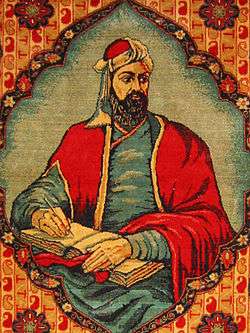 |
| Part of a series on |
| Nizami Ganjavi |
|---|
| The Panj Ganj |
|
| Related Topics |
| Monuments |
|
Nizami Mausoleum • Nizami Museum of Azerbaijani Literature • Nizami Gəncəvi (Baku Metro) • in Ganja • in Baku • in Beijing • in Chișinău • in Rome • in Saint Petersburg • in Tashkent |
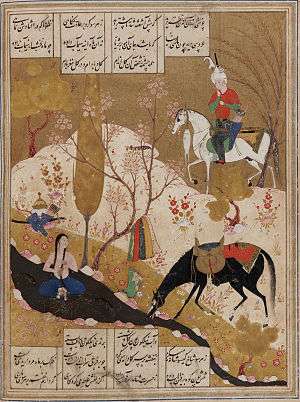
_of_Firdawsi%2C_late_15th-early_16th_century.jpg)
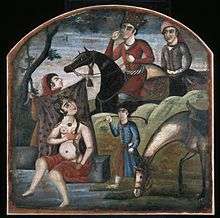
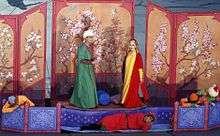
Khosrow and Shirin (Persian: خسرو و شیرین) is the title of a famous Persian tragic romance by the poet Nizami Ganjavi (1141–1209), who also wrote Layla and Majnun. It tells a highly elaborated fictional version of the story of the love of the Sasanian king Khosrow II for the Armenian princess Shirin, who becomes queen of Persia.[1][2][3][4] The essential narrative is a love story of Persian origin which was already well-known from the great epico-historical poem the Shahnameh and other Persian writers and popular tales, and other works have the same title.[5]
Variants of the story were also told under the titles "Shirin and Farhad" (Persian: شیرین و فرهاد).
Plot
Nezami's version begins with an account of Khosrow's birth and his education. This is followed by an account of Khosrow's feast in a farmer's house; for which Khosrow is severely chastised by his father. Khosrow asks forgiveness and repents his offence. Hormizd IV, who is now pleased with his son, forgives him. That very night, Khosrow sees his grandfather Anushirvan in a dream and Anushirvan gives him glad tidings of a wife named Shirin, a steed named Shabdiz, a musician named Barbad, and a great kingdom, that is Persia.
Shapur, Khosrow's close friend and a painter, tells Khosrow of the Armenian queen Mahin Banu and her niece Shirin. Hearing Shapur's descriptions of Shirin's flawless features, the young prince falls in love with Shirin, the Armenian princess. Shapur travels to Armenia to look for Shirin. Shapur finds Shirin and shows the image of Khosrow to Shirin. Shirin falls in love with Khosrow and escapes from Armenia to Khosrow's capital Mada'in; but meanwhile, Khosrow also flees from his father's anger and sets out for Armenia in search of Shirin.
On the way, he finds Shirin unclothed bathing and washing her flowing hair; Shirin also sees him; but since Khosrow was traveling in peasant clothes, they do not recognize one another. Khosrow arrives in Armenia and is welcomed by Shamira the queen of Armenia - yet he finds out that Shirin is in Mada'in. Again, Shapur is sent to bring Shirin. When Shirin reached Armenia again, Khosrow – because of his father's death- has to return to Mada'in. The two lovers keep going to opposite places till finally Khosrow is overthrown by a general named Bahrām Chobin and flees to Armenia.
In Armenia, Khosrow finally meets Shirin and is welcomed by her. Shirin, however, does not agree to marry Khosrow; unless Khosrow first claims his country back from Bahram Chobin. Thus, Khosrow leaves Shirin in Armenia and goes to Constantinople. The Caesar agrees to assist him against Bahram Chobin on condition that he marry his daughter Mariam. Khosrow is also forced to promise not to marry as long as Mariam is alive. Khosrow succeeds in defeating his enemy and reclaims his throne. Mariam, due to her jealousy, keeps Khosrow away from Shirin.
Meanwhile, a sculptor named Farhad falls in love with Shirin and becomes Khosrow's love-rival. Khosrow cannot abide Farhad, so he sends him as an exile to Behistun mountain with the impossible task of carving stairs out of the cliff rocks. Farhad begins his task hoping that Khosrow will allow him to marry Shirin. Yet, Khosrow sends a messenger to Farhad and gives him false news of Shirin's death. Hearing this false news, Farhad throws himself from the mountaintop and dies. Khosrow writes a letter to Shirin, expressing his regret for Farhad's death. Soon after this incident, Mariam also dies. According to Ferdowsi's version, it was Shirin who secretly poisoned Mariam. Shirin replies to Khosrow's letter with another satirical letter of condolences.
Khosrow, before proposing marriage to Shirin, tries to have intimacy with another woman named Shekar in Isfahan, which further delays the lovers' union. Finally, Khosrow goes to Shirin's castle to see her. Shirin, seeing that Khosrow is drunk, does not let him in the castle. She particularly reproaches Khosrow for his intimacy with Shekar. Khosrow, sad and rejected, returns to his palace.
Shirin eventually consents to marry Khosrow after several romantic and heroic episodes. Yet, Shiroyeh, Khosrow's son from his wife Mariam, is also in love with Shirin. Shiroyeh finally murders his father Khosrow and sends a messenger to Shirin conveying that after one week, she would have to marry him. Shirin, in order to avoid marrying Shiroy, kills herself. Khosrow and Shirin were buried together in one grave.
Popularity in Persian literature
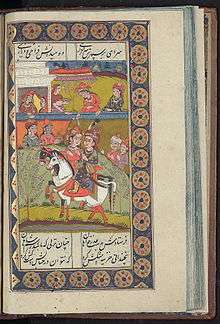
There are many references to the legend throughout the poetry of other Persian poets including Farrokhi, Qatran, Mas'ud-e Sa'd-e Salman, Othman Mokhtari, Naser Khusraw, Anwari and Sanai. Nizam al-Mulk mentioned that the legend was a popular story in his era.[6]
Nizami's version
Although the story was known before Nizami, it was brought to its greatest romantic height by him. Unlike the Shahnameh, which focuses on the history, kingship and battles of Khosrow, Nizami decided to focus on the romantic aspect of the story.
When the Seljuq Sultan Arsalan Shah requested a love epic from the poet without specifying the subject further, Nizami picked on the story of lovers Khosrow and Shirin, a theme set in his own region and based on at least partly historical facts, though an aura of legend already surrounded it.
Nizami Ganjavi (1141–1209) himself considered it the sweetest story in the world:
| “ | The tale of Khosraw and Shirin is well known And by Truth, there is no sweeter story than it. |
” |
It is believed to be one of the best works of Nizami. His first wife Afaq died after it was completed. Many versions of Nizami's work have been retold. The story has a constant forward drive with exposition, challenge, mystery, crisis, climax, resolution, and finally, catastrophe.
Besides Ferdowsi, Nizami's poem was influenced by Asad Gorgani and his "Vis and Rāmin".[7] which is of the same meter and has similar scenes. Nizami's concern with astrology also has a precedent in the elaborate astrological description of the night sky in Vis and Ramin. Nizami had a paramount influence on the romantic tradition, and Gorgani can be said to have initiated much of the distinctive rhetoric and poetic atmosphere of this tradition, with the absence of the Sufi influences, which are seen in Nizami's epic poetry.
Influence
According to the Encyclopædia Iranica: "The influence of the legend of Farhad is not limited to literature, but permeates the whole of Persian culture, including folklore and the fine arts. Farhad's helve supposedly grew into a tree with medicinal qualities, and there are popular laments for Farhad, especially among the Kurds (Mokri)."[6]
In 2011, the Iranian government's censors refused permission for a publishing house to reprint the centuries-old classic poem that had been a much-loved component of Persian literature for 831 years. While the Iranian Ministry of Culture and Islamic Guidance offered no immediate official explanation for refusing to permit the firm to publish their eighth edition of the classic, the Islamic government's concerns reportedly centered on the "indecent" act of the heroine, Shirin, in embracing her husband.[8]
Orhan Pamuk's novel My Name Is Red (1998) has a plot line between two characters, Shekure and Black, which echoes the Khosrow and Shirin story, which is also retold in the book. The novel uses the Turkish spelling of Khosrow's name, Hüsrev.
Other versions
The tale has been retold by countless Sufi poets and writers in areas which were previously part of the Persian Empire or had Persian influences, such as the northern parts of the neighboring Indian subcontinent. In Europe, the story was told by Hungarian novelist Mór Jókai. However, the story is usually told under the name of "Shirin Farhad". It is a standard tale used in Punjabi Qisse. The story has been filmed five times: 1926,[9] 1931,[10] 1945,[11] 1956 starring Madhubala and Pradeep Kumar[12] and 1975.[13]
The tale was used as the inspiration for a 2008 Iranian film, Shirin, made by Abbas Kiarostami. In this formally unusual film, the story is told via the reactions of an audience of Iranian women as they sit watching the film in a cinema. The viewer has to divine the story by only ever seeing these emoting faces and listening to the film's soundtrack.
The story was also referenced in the Jonathan Richman song "Shirin and Farhad"
The tale was also an inspiration for the 2012 Bollywood romantic comedy Shirin Farhad Ki Toh Nikal Padi.
See also
References
- ↑ The Encyclopædia Iranica ("Ḵosrow o Širin" Encyclopædia Iranica, Paola Orsatti)"Two traditions soon formed around the figure of Širin: one in her favor, with its roots in Armenia and in the Christian regions of the Caucasus, where, as we have seen, Neẓāmi found his source; and the second, represented in the Šāh-nāma, where Širin is shown as a woman of humble origin and ill repute, who makes merciless use of poison (in Ferdowsi, Širin, wrought with jealousy, poisons Maryam)."
- ↑ The Encyclopædia Iranica ("Farhad" Encyclopædia Iranica, Heshmat Moayyad)
- ↑ The Khuzistan Chronicle, written by a Syriac Christian from Khuzistan (Beth Huzaye in Aramaic/Syriac) [Iran], probably in 680, is described as the Syriac counterpart of the Armenian work of Sebeos. We read about the relationship between the bishop Isho Yahb and the Persian king Khosrau II Parvez (590–628): "Isho Yahb was treated respectfully throughout his life, by the king himself and his two Christian wives Shirin the Aramean and Mary the Roman". (Theodor. Nöldeke: Die von Guidi herausgegebene syrische Chronik, Wien 1893, p. 10.) The Chronicle of Séert (Siirt) is an anonymously authored historiographical text written by the Nestorian Church in Persia and the Middle East, possibly as early as the 9th century AD. The text deals with ecclesiastical, social, and political issues of the Christian church giving a history of its leaders and notable members. LVIII. – History of Khosrau Parvez, son of Hormizd "Khosrau, by gratitude for Maurice, ordered to rebuild churches and to honor the Christians. He built himself two churches for Marie (Maryam) and a large church and a castle in the country of Beth Lashpar for his wife Shirin, the Aramean." (Patrologia Orientalis, Tome VII. – Fascicule 2, Histoire Nestorienne (Chronique de Séert), Seconde Partie (1), publiée et traduite par Mgr Addai Scher, Paris 1911, Published Paris : Firmin-Didot 1950 p. 467.)
- ↑ Johan Christoph Burgel & Christine van Ruyuymbeke, "Nizami: A Key to the Treasure of the Hakim ", Amsterdam University Press, 2011. pg 145: "Shirin is presented as an Armenian princess
- ↑ Chelkowski, P. "Nezami's Iskandarnameh:"in Colloquio sul poeta persiano Nizami e la leggenda iranica di Alessandro magno, Roma,1977). pp 10: "The Persian legend of Alexander the Great seems to overshadow all of the other fantastic Alexander stories not only in the tale of the successful accomplishment of many a "mission-impossible" but especially concerning the nature of his career. In Iran he rose from the stature of a damned evil conqueror of the country, to that of a national Iranian hero king, and even more, to that of the great prophet of God, preparing all the nations for the true religion. Yet the Persian legend of Alexander is very little known in the Western world."" pp 13: "Nizami was a typical product of the Iranian culture. He created a bridge between Islamic Iran and pre-Islamic Iran and also between Iran and the whole ancient world. His great humanism, strong character, sensibility, drama, colorful description of nature, rich language, and the poetic genius created a new standard of literary achievements and captured the imagination of countless imitators". pg 17: "In the case of previous romances of Khosraw and Bahram, Nizami dealt with national Iranian heroes, though from pre-Islamic times. In the tale of Layla and Majnun, the Arab nationality of the lover is of no importance since the story is based on a simple Arab folktale which was later absorbed and embellished by the Persians". pp 19: "Alexander was glorified by the Muslims as a divine agent, a prophet-king and the blessed conqueror of the lands that were to become the stronghold of Islam. To some Muslims, Islam was a realization of Alexander's "koine" --- a commonwealth where people could live in harmony and in peace of heart and mind. In this atmosphere attempts were made to make out of Alexander not only a Muslim but a Persian as well". pg 21: "However, it was not Tabari directly, but Ferdowsi who was Nizami's source of inspiration and material in composing Iskandarnameh. Nizami constantly alludes to the Shahnameh in his writing, especially in the prologue to the Iskandarnameh. It seems that he was always fascinated by the work of Firdawsi and made it a goal of his life to write an heroic epic of the same stature. pg22: "It seems that Nezami's favorite pastime was reading Firdawsi's monumental epic Shahnameh (The book of Kings)". pg 22: "In fact, although Alexander conquered Iran, he was soon conquered by Persian customs and ways of life. In many aspects he was so overwhelmed by Persian civilization that he became more Persian than the Persians. He tried to make a blend of the Greek and Persian civilization --- even genetically, when he sponsored mass marriages between his troops and Persian women. He himself married Roxane (Rowshanak) the daughter of the Sogdian prince – not the daughter of Darius the Third, as both Firdawsi and Nizami believed. Like Alexander, Arabs, Turks, Mongols and other people who overran the Iranian plateau also came under the spell of Persian culture. Foreign invaders remained to become contributors and patrons of Persian art and culture. To give one example, some of Nizami's benefactors were of Turkic stock."
- 1 2 Heshmat Moayyad (1999-12-15). "Farhad". Encyclopedia Iranica. Retrieved 2010-07-26.
- ↑ Dick Davis (2005-01-06). "Vis o Rāmin". Encyclopaedia Iranica. Retrieved 2008-04-25.
- ↑ "Iranian Censors' Heavy Hand Falls On A Persian Classic". RadioFreeEurope/RadioLiberty.
- ↑ Shirin Farhad (1926) on IMDb
- ↑ Shirin Farhad (1931) on IMDb
- ↑ Shirin Farhad (1945) on IMDb
- ↑ Shirin Farhad (1956) on IMDb
- ↑ Shirin Farhad (1975) on IMDb
External links
| Wikimedia Commons has media related to Khosrow and Shirin. |
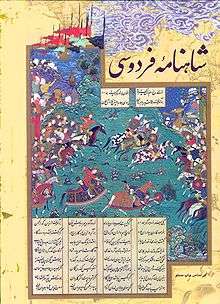
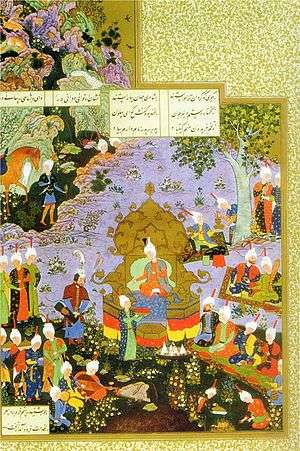
.png)